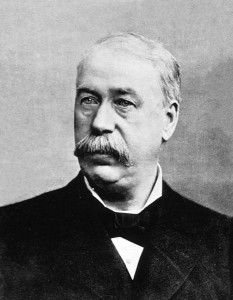By Jack El-Hai, Wonders & Marvels contributor
Although we’re crazy for adorning ourselves with gold, humans have invoked a variety of health reasons to take the precious metal inside our bodies, as well. Gold components often go into such implanted devices as heart pacemakers, not to mention dental work. A liquid suspension called colloidal gold may have uses in the treatment of rheumatoid arthritis and in the delivery of tiny amounts of medications.
Of all the benefits ascribed to the medical exploitation of gold, perhaps the strangest belonged to Leslie M. Keeley, a nineteenth-century physician who convinced countless desperate people that gold could cure them of drinking and doping.
Keeley, who had doctored Civil War troops as a member of the Union Army medical corps, in 1880 first combined the special ingredients of his “Bichloride of Gold” nostrum and declared it a cure for chemical addictions. Over the next 11 years, he developed a marketing scheme for the compound and opened the first Keeley Institute in Dwight, Illinois, in 1891. By 1900, the year of Keeley’s death, there were Keeley Institutes in every state. Keeley hit upon his “cure” at an opportune time when other treatment choices for alcohol and drug addicts offered little genuine chance for recovery.
Keeley’s cure thrived for a time because it offered the credibility of a pseudoscientific explanation for addiction. He declared that alcoholism resulted from damage to nerve cells that weakened the victim’s will power. Patients could lose their craving for alcohol and drugs only if they underwent treatment to purge their cells of poisons and restore them to proper functioning. Teamed with rest, exercise, and healthy food, draughts and injections of Keeley’s claimed “gold cure” could eliminate the addiction. Over the years, an estimated 400,000 people underwent the gold treatment at one of the scores of Keeley Institutes scattered around the U.S. Keeley’s staff claimed a cure rate of 95 percent.
Unfortunately, there was no such thing as “Bichloride of Gold.” A 1907 lawsuit exposed the actual ingredients of the Gold Cure compound: strychnine, atropine (the drug ophthalmologists use to dilate pupils), boric acid, and water — and no gold, in “bichloride” form or otherwise. Keeley was not only a quack — though he deserves some credit for treating alcoholism as a disease instead of a moral failing — but also a purveyor of fool’s gold.
Further reading:
Higby, Gregory J. “Gold in Medicine: A Review of Its Use in the West Before 1900.” Gold Bulletin, 1982, 15, (4).
Lender, Mark Edward and James Kirby Martin. Drinking in America: A History. Free Press, 1987.

